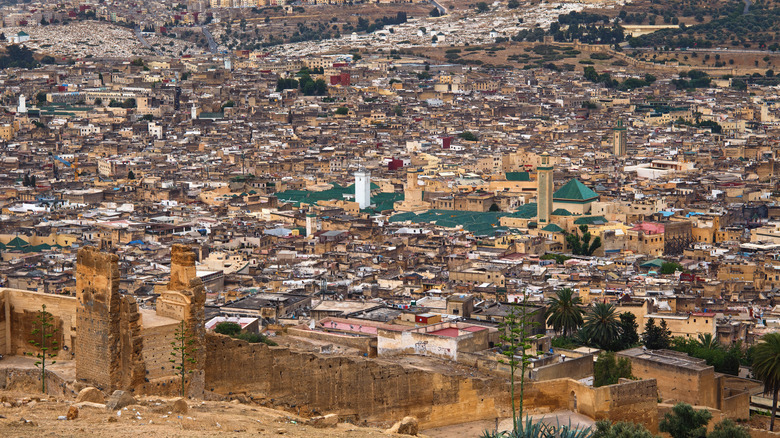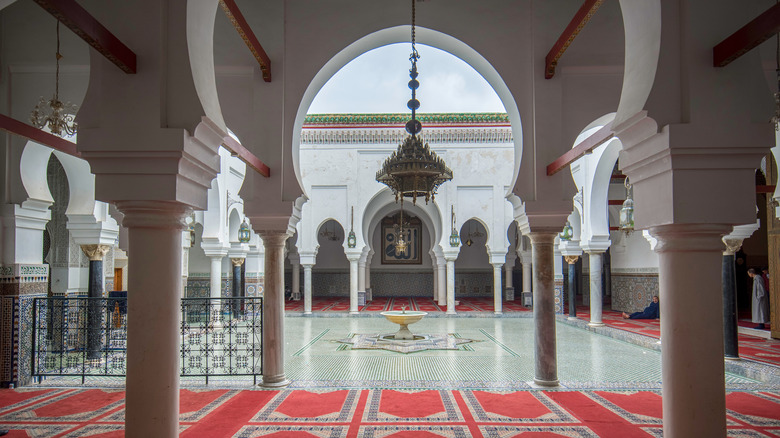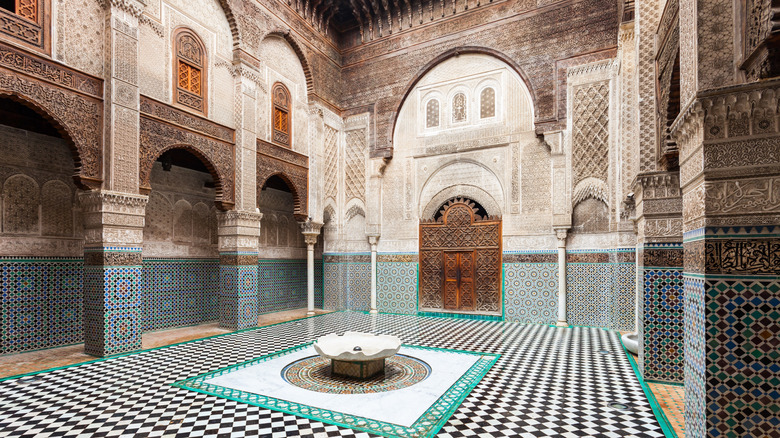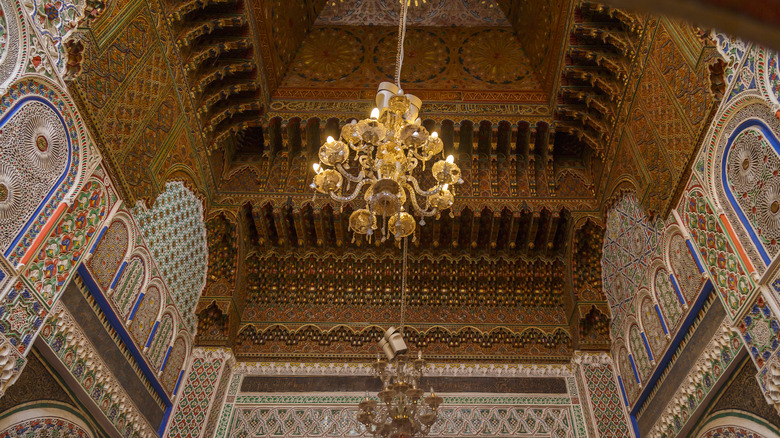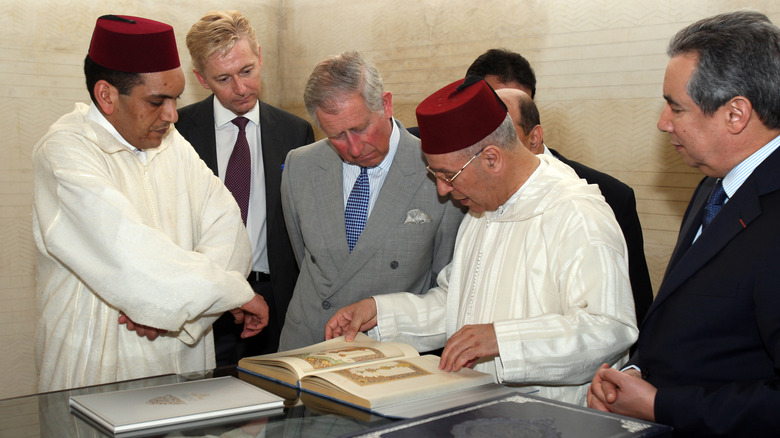Who Is The Woman Who Founded The World's Oldest Operating Library?
According to Britannica, the first systematically cataloged library was founded in the 7th Century B.C. in Nineveh by Assyrian king Ashurbanipal. The British Museum explains that Nineveh, now considered to be modern-day Iraq, was the Assyrian empire's largest city. Unlike other kings of the time, Ashurbanipal was able to read and write. Consequently, he amassed a substantial collection of more than 30,000 books that were written on clay tablets (per ThoughtCo). Although the Library of Ashurbanipal was later destroyed, its remains were discovered in 1849. The British museum now has a number of these clay tablets on display.
History reports that other ancient libraries have been lost to time for a number of reasons. The Library of Alexandria, for example, was burned down. The same can be said about The Imperial Library of Constantinople. Per The Met Museum, the Ebla Library in Syria was destroyed by conquerors. There are, however, age-old libraries that have survived the centuries and continue to be in operation today. One of these is the al-Qarawiyyin library (via Oldest). Located in Fez, Morocco, CNN writes that it opened in 859 A.D. and was founded by Fatima al-Fihri, a woman born into wealth.
Not much is known about Fatima al-Fihri
Al-Fihri was reportedly born in 800 A.D. (via DW). Although her early life is a mystery, Manchester University Press writes that she and her family emigrated from Tunisia to Fez, Morocco in the 9th century. Per Morocco World News, her father, her brother, and her husband were all prosperous merchants who died relatively young. Their deaths made al-Fihri a very well-to-do woman. Due to her family's affluence, Discovery reports, she was well-educated. She was known to be generous and humble. Al-Fihri wanted a place where everyone could learn and be educated. She then decided to use her inheritance to build a center for education (per Literary Hub).
As explained by Global Citizen, Al-Fihri was a muslim woman that loved culture, travel, and learning. Nonetheless, she was well aware that not everyone, especially women, had access to these resources. Her solution was to build Al-Qarawiyyin, an establishment that eventually transformed into a university, library, and an Islamic hub. Al-Fihri was heavily involved in the center's construction. She bought the land from a local tribe and demanded that native materials be used. Named after her birthplace, Qayrawan, in Tunisia, Al-Fihri brought in a number of scholars when construction was complete.
Fatima al-Fihri received a degree from the university she founded
Per the Manchester University Press, when al-Qarawiyyin opened in 859, it became the first academic establishment to provide students with degrees. One could be educated, but Discovery writes that prior to this, degrees and diplomas were unheard of. Al-Fihri's university, however, changed all that. Now, students were receiving an education and a certificate that proved they had completed their studies. Al-Fihri herself attended her own university and later received a degree. By the 10th century, DW explains, al-Qarawiyyin was drawing in international students and intellectuals. Subjects that were taught at the university included science, languages, and astronomy.
It's for this reason that Morocco World News refers to al-Qarawiyyin as the first cultural, educational, and religious center of the Islamic world. Forums and discussions were commonplace at the university, and several western scholars were educated here. Many students went on to be teachers or judges in Morocco (via Literary Hub). Additionally, women were allowed to participate in lectures. Al-Fihri reportedly died in 878. Although her name is not well known in the western world, DW writes that she is revered as a saint in the city of Fez. According to the Daily Sabah, al-Qarawiyyin is still open today and is considered to be the oldest university in operation.
Restoration of the library began in 2012
The Daily Sabah writes that at one point, al-Qarawiyyin had several libraries to accommodate the myriad of books they had collected. Today, however, only one library exists. According to CNN, this library was off limits for years to the public and a majority of the students at al-Qarawiyyin. This was due to the library's condition; it was in disrepair and rotting away (via TED Ideas). In 2012, the Moroccan Ministry of Culture contacted Aziza Chaouni, a Canadian-based architect and engineer. She was shocked to find that the library had suffered immense water damage throughout the years. She prepared herself for the daunting restoration.
Literary Hub explains that this project was personal for Chaouni. She is a Fez native and her grandfather was once a student at al-Qarawiyyin. Chaouni described that growing up, she was intrigued by the locked library doors she was prohibited from entering. Although she believed the library was one room with stacks of books, she discovered that it was actually "a very intricate set" of three courtyard buildings, each of them built at a different point in time. Chaouni was also aware of Al-Fihri's story and reveled in the fact that Morocco had chosen her to renovate an institution that was founded by a woman.
The library was given modern updates
TED Ideas writes that Chaouni faced an assortment of issues when it came to restoring the al-Qarawiyyin library. The Moroccan Ministry of Culture wanted to ensure that it could eventually be open to the public. However, there were structural issues and she was faced with replacing ancient mosaics and more with comparable materials. Chaouni made a number of discoveries during the restoration. According to CNN, she found a river flowing underneath the library's floors. Chaouni was forced to build an underground system that led this water to a sewer to ensure further water damage would not occur. Furthermore, her team found a secret roof and a number of hidden items behind the library's walls.
Literary Hub reports that the renovated library was modernized while still keeping its authenticity. This included solar panels and climate control. Additionally, it featured a reading room, cafe, and a lab to restore manuscripts. Chaouni digitized some of the library's oldest texts in order for them to be easily accessible. She stated that out of all of her accomplishments, restoring the library was something she was most proud of and found the process healing. As she put it, "The heritage needs to live. It can't be thought of as this mummy we need to preserve" (via CNN).
The Al-Qarawiyyin library houses important texts
CNN reports that preserving ancient texts was an important task in the restoration process of the al-Qarawiyyin library. TED Ideas writes that some of these items date back to the 12th century and overall, it's believed that the library has over 4,000 manuscripts (via Manchester University Press). According to Insider, many of them are religious. They include a Quran from the 9th century and an original copy of "Muqaddimah" by Ibn Khaldun (per NPR). Prior to the restoration, there were fears that these texts would become damaged beyond repair. Now, they are housed in a secured temperature-controlled room.
The library also proudly displays Al-Fihri's original wooden diploma that was given to her when she graduated from al-Qarawiyyin. Moreover, as The Guardian writes, the library's restoration inspired Fez to renovate other parts of their city. At the time of its reopening, there were fears that the library would be targeted by Islamic extremists. This came as Mosul University's library was destroyed and ransacked in 2015 by ISIS. Despite this, the workers at the al-Qarawiyyin library stated that "You can hurt us, but you cannot hurt the books."

